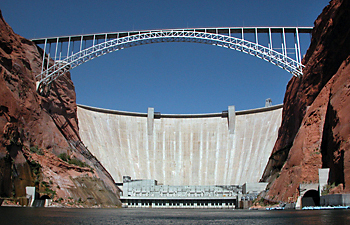
States sharing the Colorado River have outlined a Consensus-Based Modeling Alternative (CBMA) for the Bureau of Reclamation to evaluate and incorporate into its Supplemental Environmental Impact Statement (SEIS) to revise operating guidelines for Glen Canyon and Hoover dams.
The operating guidelines (’07 Guidelines) must be revised to protect critical elevations and infrastructure within the reservoirs these two dams impound, the states said. This is necessary to ensure the Colorado River system – which has been impacted by more than two decades of drought exacerbated by climate change and depleted storage – can continue to serve more than 40 million people, about 5.5 million acres of irrigated farmland, Basin Tribes, environmental resources, and power production across seven states and portions of Mexico.
Glen Canyon Dam impounds water for a 1,320 MW hydroelectric powerhouse and Hoover Dam’s associated powerhouse has a capacity of 2,078 MW.
The states of Arizona, Colorado, Nevada, New Mexico, Utah and Wyoming jointly submitted the alternative. The states say they remain committed to working cooperatively with their local water users, the federal government, other Basin states, Basin Tribes, non-governmental organizations and stakeholders throughout Reclamation’s environmental review and in accordance with the National Environmental Policy Act.
While the CBMA is not a formal agreement between the states, it serves as an alternative framework for Reclamation to analyze in its SEIS process. It provides an approach to help protect Glen Canyon Dam (Lake Powell) and Hoover Dam (Lake Mead) infrastructure, water deliveries and power production to mitigate the risk of either lake reaching dead pool.
The alternative includes, but is not limited to, the following modeling criteria for Reclamation to consider and analyze:
Adjustments to the ‘07 Guidelines, including reduced releases from Lake Powell and Lake Mead to ensure the deliverability of water downstream and power production.
Adjustments to Lower Basin contributions required under Drought Contingency Plan.
Accounting for more than 1.5 million acre-feet of losses within the Lower Basin that are necessary to protect infrastructure.
Additional combined reductions of 250,000 acre-feet to Arizona, California and Nevada at Lake Mead elevation 1,030 feet and below.
Additional combined reductions of 200,000 acre-feet to Arizona, California and Nevada at Lake Mead elevation 1,020 feet and below, as well as additional reductions necessary to protect Lake Mead elevation 1,000 feet.
Actions outlined within the Upper Basin State’s Drought Response Operations Agreement.
Additional voluntary conservation measures that take into account hydrologic shortage in the Upper Division States.
“The CBMA includes the significant and necessary step of assessing evaporation and transit losses against Lower Basin uses. The Lower Basin actions operate in coordination with additional actions in the Upper Basin,” said Becky Mitchell, Colorado Commissioner, Upper Colorado River Commission and Director Colorado Water Conservation Board of the Colorado River Department of Natural Resources. “We can only save the Colorado River system if we act together. The CBMA approach appropriately distributes the burden across the Basin and provides safeguards for the Tribes, water users, and environmental values in the Upper Basin.”